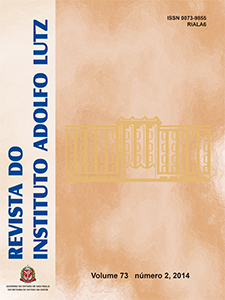Abstract
Cronobacter spp. is an opportunistic bacterium that is associated with infection outbreaks in neonates and infants due to the consumption of powdered infant formulas (PIF). In this context, the official regulator sector has created the specific standards for the industries to control these pathogens in the PIF. The present study aimed at evaluating the occurrence of Cronobacter spp. in 60 samples of PIF commercialized in Rio de Janeiro, Brazil. Thirty samples of infant formulas (0-6 months) and 30 samples of follow-up infant formulas (> 6 months) were analyzed according to the conventional methodologies described in the Bacteriological Analytical Manual Online-FDA (2012). The identification of characteristic colonies was performed using kits ID32E, API20E andVitek 2.0 system and polymerase chain reaction (PCR) targeting the gluA gene. No sample showed contamination by Cronobacter spp. The occurrence of Cronobacter spp. in PIF seems to be low, indicating that the producers are complying with the provisions of the Brazilian standards in force to avoid the product contamination by this microorganism.References
1. Codex Alimentarius Comission - CAC. Codex Alimentarius: code of hygienic practice for foods for powdered formulae for infants and young children. CAC/RCP 66. 2008. [acesso 2014 Jan 10]. Disponível em: [http://www.codexalimentarius.org/standards/list-of-standards/en/?no_cache=1].
2. Food and Agricultural Organization /World Health Organization – FAO/WHO. Enterobacter sakazakii and Salmonella in powdered infant formula. Meeting Report. Genova: WHO, 2006. 115p. Microbiological Risk Assessment Series Nº 10. [acesso 2014 Jan 10]. Disponível em: [http://www.who.int/foodsafety/publications/micro/mra10/en/].
3. Santos M, Pessoa da Silva CL, Sampaio J, Marangoni DV, Pinto M, Moreira BM. Detection and control of Enterobacter sakazakiisepsis outbreak in four hospitals in Rio de Janeiro, Brazil. Infect Control Hosp Ep.2000;21(2):140.
4. Warnken MB, Brandao MLL, Souza AE, Romão CMCP, Nogueira ACMA, Destro MT. Phenotypic profiles and detection of target genes by PCR in isolates from different sources and reference strains, identified as Cronobacter spp. (Enterobacter sakazakii). Rev Inst Adolfo Lutz.2012;71(1):21-31.
5. Brasil. Ministério da Saúde. Agência Nacional de Vigilância Sanitária. Resolução RDC n.º12, de 2 de janeiro de 2001. Aprova regulamento Técnico sobre Padrões Microbiológicos para alimentos e seus anexos I e II. Diário Oficial [da] União, Poder Executivo, Brasília, DF, n.7-E, 10 jan. 2001. Seção 1, p 45.
6. Brasil. Ministério da Saúde. Agência Nacional de Vigilância Sanitária. Resolução RDC n.º43 de 19 de setembro de 2011. Dispõe sobre o regulamento técnico para fórmulas infantis para lactantes. Diário Oficial [da] União, Poder Executivo, Brasília, DF, n. 182, ISSN 1677-7042, 21 set. 2011. Seção 1, p 90-2.
7. Brasil. Ministério da Saúde. Agência Nacional de Vigilância Sanitária. Resolução RDC n.º44 de 19 de setembro de 2011. Dispõe sobre o regulamento técnico para fórmulas infantis de seguimento para lactantes e crianças de primeira infância. Diário Oficial [da] União, Poder Executivo, Brasília, DF, n. 182, ISSN 1677-7042, 21 set. 2011. Seção 1, p 92-4.
8. Brasil. Ministério da Saúde. Agência Nacional de Vigilância Sanitária. Resolução RDC n.º45 de 19 de setembro de 2011. Dispõe sobre o regulamento técnico para fórmulas infantis lactantes destinadas a necessidades dietoterápicas específicas e fórmulas infantis de seguimento para lactantes e crianças de primeira infância destinadas a necessidades dietoterápicas específicas. Diário Oficial [da] União, Poder Executivo, Brasília, DF, n. 182, ISSN 1677-7042, 21 set. 2011. Seção 1, p 94-6.
9. International Organization for Standardization - ISO. ISO/TS 22964 (IDF/RM 210:2006). Milk and milk products – Detection of Enterobacter sakazakii. 2006. 13p.
10. Chen Y, Lampel K, Hammack T. Cronobacter. In: Bacteriological analytical manual. 8ª ed. Revision A, 1998. United States: Food and Drug Administration. Chapter 29, mar. 2012. [acesso 2014 Jan 10]. Disponível em: [http://www.fda.gov/Food/FoodScienceResearch/LaboratoryMethods/ucm289378.htm].
11. Iversen C, Lehner A, Mullane N, Marugg J, Fanning S, Stephan R, et al. The identification of Cronobacter spp. (Enterobacter sakazakii). J Clin Microbiol.2007;45(11):3814-16.
12. Santos RFS, Silva N, Junqueira VCA, Kajsik M, Forsythe S, Pereira JL. Screening for Cronobacter Species in Powdered and Reconstituted Infant Formulas and from Equipment Used in Formula Preparation in Maternity Hospitals. Ann Nutr Metab.2013;63(1-2):62-8.
13. Abdullah Sani N, Hartantyo SH, Forsythe SJ. Microbiological assessment and evaluation of rehydration instructions on powdered infant formulas, follow-up formulas, and infant foods in Malaysia. J Dairy Sci.2013;96(1):1-8.
14. Chap J, Jackson P, Siqueira R, Gaspar N, Quintas C, Park J, et al. International survey of Cronobacter sakazakii and other Cronobacter spp. in follow up formulas and infant foods. Int J Food Microbiol.2009;136(2):185-8.
15. Freitas LG, Ristori CA, Jakabi M, Paula AMR, Rowlands REG. Ocorrência de Cronobacter spp. (Enterobacter sakazakii) em alimentos infantis adquiridos em um hospital público. Rev Inst Adolfo Lutz.2011;70(4):548-53.

This work is licensed under a Creative Commons Attribution 4.0 International License.
Copyright (c) 2015 Instituto Adolfo Lutz Journal
